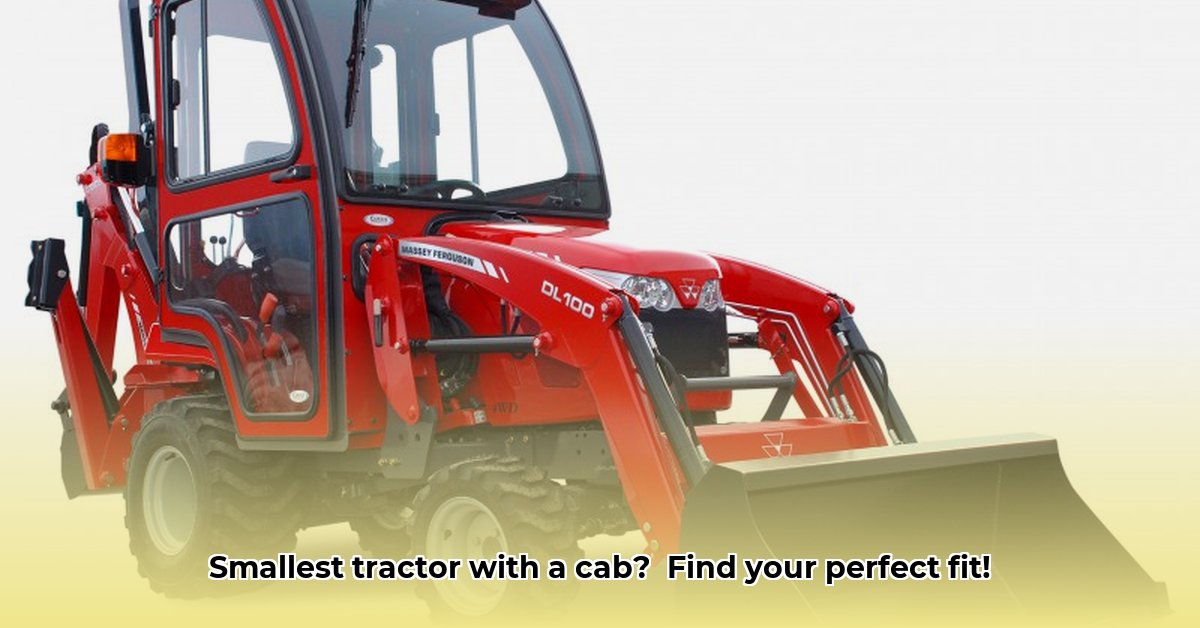
Finding the right compact tractor can significantly impact the efficiency and sustainability of your farming operation. A tractor with a cab offers crucial operator comfort and safety, particularly important for extended work periods. This guide explores the market for the smallest tractors with cabs, focusing on key models and providing actionable advice to help you find the perfect fit. For more in-depth information on compact tractor models, check out this helpful resource.
Navigating the Compact Tractor Market
The market for compact tractors, especially those with enclosed cabs, is booming. Major players like John Deere and Yanmar offer a range of options, yet finding readily comparable specifications across brands remains a challenge. Manufacturers often present information differently, making direct comparisons difficult. This guide aims to clarify the options, although complete comparative data remains limited.
Getting a Closer Look at Key Models
Direct comparison of all available models is hindered by inconsistent data availability. However, we'll examine some popular options, including the John Deere 3 Series, for which more information is readily accessible.
John Deere 3 Series
The John Deere 3 Series is a well-regarded option known for its versatility and available options. The enclosed cab offers comfort and protection from the elements. Horsepower varies greatly within the 3 Series; models range from approximately 37 to 73 HP. Higher horsepower generally means more lifting capacity and suitability for heavier tasks. However, fuel efficiency will also vary by model and workload; consider your typical tasks when choosing your specific model.
Yanmar YT Series
Yanmar's YT series is a strong competitor, known for its reliability. However, detailed specifications, especially for direct comparison, are less consistently available online. This makes direct comparison with the John Deere 3 Series difficult.
Feature Comparison Table (Limited Data)
Due to data limitations, a complete feature-by-feature comparison across multiple brands is currently not feasible. The table below shows general information where available.
| Feature | John Deere 3 Series (Example) | Yanmar YT Series (Limited Data) | Considerations |
|---|---|---|---|
| Horsepower | 37-73 HP (model-dependent) | Varies considerably | Match to your workload; higher HP generally means more lifting power. |
| Lifting Capacity | Varies depending on the specific model | Data not consistently available | Crucial for moving heavy implements or produce. |
| Fuel Efficiency | Varies depending on model and usage | Information varies significantly | Consider your typical workload and fuel costs. |
| Cab Features | Climate control (often standard); enhanced comfort and visibility | Features and availability vary | Essential for all-weather operation and operator comfort. |
Choosing Your Perfect Compact Tractor: A Step-by-Step Guide
Selecting the ideal compact tractor involves careful consideration of several factors. The following steps provide a framework for your decision-making process:
Define Your Budget: Set a realistic budget encompassing the tractor, attachments, and potential maintenance costs. Overspending can significantly impact your farm's finances.
Assess Your Land and Tasks: Determine the acreage you need to manage and the planned tasks (tilling, mowing, hauling, etc.). This dictates the necessary horsepower and features. For instance, a larger acreage generally requires more power.
Consider Your Experience: Beginners may benefit from a more user-friendly model. Experienced operators may prefer greater customization and control.
Prioritize Features: Create a prioritized list of "must-have" and "desirable" features based on your needs and budget. This helps navigate the many available options effectively. A cab, for example, is a must-have feature for some, not for others.
Research and Compare: Use your checklist to research and compare models. Consult manufacturer websites, reviews, and even local dealerships to gather information.
Test Drive (If Possible): Arrange a test drive if feasible. This is crucial for evaluating the tractor's performance, maneuverability, and comfort.
Attachments: Expanding Your Tractor's Versatility
Attachments significantly expand the capabilities of your compact tractor. Consider the iMatch™ Quik-Hitch system for quick and easy tool changes. Common attachments include front-end loaders, backhoes, tillers, mowers, and snow blowers – choose based on your specific agricultural needs.
Maintenance and Safety: Crucial Considerations
Regular maintenance is crucial for optimal performance and longevity. Follow the manufacturer's recommended maintenance schedule, including oil changes, filter replacements, and vital system checks. Safe operation is paramount. Always wear appropriate safety gear and thoroughly review the operator's manual before using the tractor.
Conclusion
Finding the smallest tractor with a cab for your sustainable farming needs requires thoughtful planning. By following the steps outlined and considering the options discussed, you can make an informed decision that aligns with your farm’s specific requirements and budget. Remember to prioritize safety and regular maintenance for a productive and enjoyable farming experience.
Resources
- John Deere: [Insert John Deere Website Link]
- Yanmar: [Insert Yanmar Website Link]
- Your State's Department of Agriculture: (Search for your state's Department of Agriculture website for potential grant information)